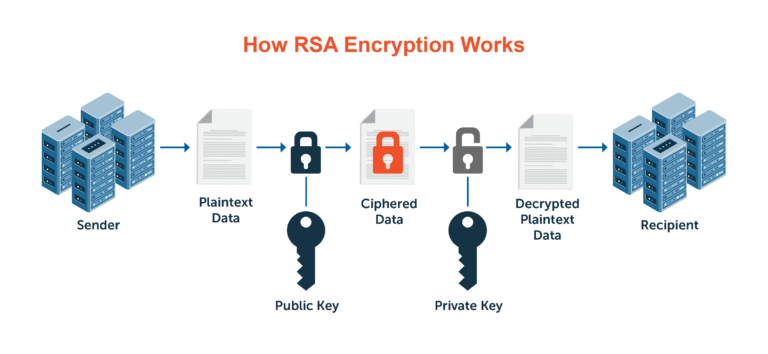The digital age is replete with various encryption methods aimed at securing sensitive data and communications. Among these, RSA encryption—a cornerstone of modern cryptography—has stood the test of time. Yet, does the continued reliance on RSA signal confidence or a willingness to embrace potential vulnerabilities? One must consider the limitations inherent in using RSA encryption online, as these boundaries form critical considerations for both developers and end-users alike.
First, let’s explore the computational intensity required by RSA. The algorithm relies on the mathematical prowess of large prime numbers upon which it generates keys. However, the larger the keys, the more computational resources are needed for encryption and decryption. This can lead to noticeable latency in transactions, especially on devices with constrained processing capabilities, such as smartphones or IoT devices. What does this mean for user experience? A sluggish interface may frustrate users, potentially driving them away from applications that prioritize security but compromise on speed. Additionally, as data transactions burgeon, this computational burden may become an increasingly cumbersome challenge for server operations.
Moreover, RSA’s reliance on public and private keys ushers in another limitation: key management. The effectiveness of RSA encryption is contingent upon maintaining the secrecy of the private key. If a malicious actor intercepts the private key, they gain unfettered access to sensitive data. This is particularly problematic when considering that key compromise can occur due to human error, lax security protocols, or even physical theft. Organizations must implement rigorously secure methods for storing and distributing keys, adding an additional layer of complexity to the encryption process. Are the safeguards and requisite infrastructure always in place to ensure robust key management?
In addition to the intricacies of key management, RSA’s security framework is susceptible to advances in algorithmic tactics and computational technology. Historical milestones in computational power—such as the advent of quantum computing—have raised substantial trepidations for RSA encryption. Quantum computers, with their prodigious capabilities, could obviate the complex mathematical barriers that protect RSA encrypted data. This impending threat makes it imperative for cryptography experts to consider transitioning to quantum-resistant algorithms. As quantum technologies evolve, will RSA prove to be a capable defender against an adversary wielding unprecedented computational might?
Another formidable drawback of RSA encryption is the vulnerability to varied types of attacks. It is not merely the sheer power of a quantum computer that poses a risk; rather, RSA can be compromised through other avenues. For example, common attacks such as chosen ciphertext attacks or timing attacks can exploit weaknesses in the implementation of RSA protocols. Attackers can manipulate the encryption process in subtle ways to glean private information. The implementation itself can become an Achilles’ heel, leading one to wonder: is relying solely on RSA for encryption enough, or must one integrate multifaceted security layers to preserve data integrity?
Further complicating the security landscape is the matter of encryption size. RSA requires longer key lengths to maintain security levels against evolving threats—typically 2048-bits for current applications, with a movement towards even larger keys. However, larger keys necessitate more processing time and increase the amount of data to be transmitted. This creates a dichotomy between security and practicality, urging developers to ask themselves: are their applications willing to sacrifice efficiency for enhanced safety, or can they strike a more harmonious balance?
Let’s shift our focus toward the context of digital signatures, a significant use case for RSA. In theory, RSA offers an elegant solution for ensuring authenticity and non-repudiation of messages. Yet, the operational overhead of using RSA for digital signatures can hinder implementation across large systems. Efficiency is paramount, particularly for high-transaction environments or those involving multiple signatures. Furthermore, the potential for signature forgery through vulnerabilities in the algorithm necessitates continuous scrutiny. The pressing question remains: can new methodologies emerge that simplify verification processes without losing the essential attributes that make RSA integral to digital transactions?
In the realm of online applications, user awareness presents an additional limitation for effective RSA utilization. Many end-users lack understanding regarding the principles of encryption, leading to an overreliance on perceived security. This knowledge gap can precipitate a false sense of security, possibly rendering users susceptible to phishing attacks or other social engineering tactics. It drives home the importance of user education and transparent security practices—what good is RSA encryption if users don’t comprehend its function or limitations?
As we traverse the complex landscape of online encryption, it becomes evident that while RSA plays a crucial role in safeguarding digital communications, its limitations are multifaceted. The reliance on computational resources, key management complexities, vulnerability to technological advances, potential for diverse attacks, and challenges in user understanding all emanate from its widespread usage. Therefore, rather than languishing in complacency with RSA, it is vital for cryptographers and developers to investigate emerging technologies and alternative encryption methods that could augment or replace traditional RSA structures. The conundrum persists: can we ensure data security in a rapidly evolving digital world while accountably managing the imperfections of our existing encryption methodologies?









Leave a Comment